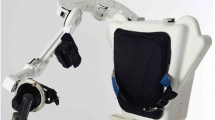Abstract
The aim of the study was the biomechanical assessment of selected motor and cognitive exercises carried out with the use of the Neuroforma rehabilitation system. The selected parameters of the kinematics of the upper limbs’ movements during exercises with the Neuroforma system were compared with the kinematics of the movement of selected activities used in daily living. The reference group consisted of 17 adults without any musculoskeletal disorders. For the reference group, studies of the kinematics of the movement of the upper limbs were carried out using the Xsens system. Tasks performed during these activities included actions such as drinking from a cup or lifting an object on a platform. The study of the kinematics of movement of selected cognitive-motor exercises (“Paths”, “Track”) with the Neuroforma system was carried out for one healthy adult. It has been shown that the maximum value of angles and ranges of motion in the shoulder and elbow joints during exercise in the Neuroforma system is higher than in the analyzed everyday activities. Moreover, the values of the analyzed kinematic parameters do not increase linearly with the increase made in the levels of the analyzed exercises. The type and level of exercise in the system should be selected by the doctor/physiotherapist individually on the basis of the patient’s mobility capabilities, based on medical knowledge and a biomechanical assessment of movements made for specific exercises and their levels.
Access this chapter
Tax calculation will be finalised at checkout
Purchases are for personal use only
Similar content being viewed by others
References
Adomavičienė A, Daunoravičienė K, Kubilius R, Varžaitytė L, Raistenskis J (2019) Influence of new technologies on post-stroke rehabilitation: a comparison of Armeo spring to the kinect system. Medicina (Kaunas) 55(4):98
Aizawa J, Masuda T, Koyama T, Nakamaru K, Isozaki K, Okawa A, Morita S (2010) Three-dimensional motion of the upper extremity joints during various activities of daily living. J Biomech 43:2915–2922
Borrego A, Latorre J, Llorens R, Alcañiz M, Noé E (2016) Feasibility of a walking virtual reality system for rehabilitation: objective and subjective parameters. J Neuroeng Rehabil 13(1):68
Cano Porras D, Siemonsma P, Inzelberg R, Zeilig G, Plotnik M (2018) Advantages of virtual reality in the rehabilitation of balance and gait: systematic review. Neurology 90(22):1017–1025
Chanpimol S, Seamon B, Hernandez H, Harris-Love M, Blackman MR (2017) Using Xbox kinect motion capture technology to improve clinical rehabilitation outcomes for balance and cardiovascular health in an individual with chronic TBI. Arch physiother 7:6
de Amorim J, Leite RC, Brizola R, Yonamine CY (2018) Virtual reality therapy for rehabilitation of balance in the elderly: a systematic review and META-analysis. Adv Rheumatol (London, England) 58(1):18
Gieser S, Becker E, Makedon F (2013) Using CAVE in physical rehabilitation exercises for rheumatoid arthritis. In: ACM international conference proceeding series. https://doi.org/10.1145/2504335.2504367
Guzik-Kopyto A, Michnik R, Wodarski P, Chuchnowska I (2016) Determination of loads in the joints of the upper limb during activities of daily living. In: Piętka E, Badura P, Kawa J, Wieclawek W (eds) Information technologies in medicine 5th international conference ITIB 2016, Kamień Śląski, Poland, 20–22 June 2016. Advances in Intelligent Systems and Computing, vol 472. Springer, Cham, pp 99–108
Harkema SJ, Schmidt-Read M, Lorenz DJ, Edgerton VR, Behrman AL (2012) Balance and ambulation improvements in individuals with chronic incomplete spinal cord injury using locomotor training-based rehabilitation. Arch Phys Med Rehabil 93(9):1508–1517
Hussain N, Murphy MA, Sunnerhagen KS (2018) Upper limb kinematics in stroke and healthy controls using target-to-target task in virtual reality. Front Neurol 9:300
Kyung K, Won-Kyung S, Jeongsu L, Hwi-Young L, Dae-Sung P, Byung-Woo K, Jongbae K (2014) Kinematic analysis of upper extremity movement during drinking in hemiplegic subjects. Clin Biomech 29:248–256
Magermans DJ, Chadwick EKJ, Veeger HEJ, van der Helm FCT (2005) Requirements for upper extremity motions during activities of daily living. Clin Biomech 20:591–599
Mekbib DB, Han J, Zhang L, Fang S, Jiang H, Zhu J, Roe AW, Xu D (2020) Virtual reality therapy for upper limb rehabilitation in patients with stroke: a meta-analysis of randomized clinical trials. Brain Inj 34(4):456–465
Park DS, Lee DG, Lee K, Lee G (2017) Effects of virtual reality training using Xbox kinect on motor function in stroke survivors: a preliminary study. J Stroke Cerebrovasc Diseases Off J Natl Stroke Assoc 26(10):2313–2319
Stryla W, Banas A (2016) The use of virtual reality technologies during physiotherapy of the paretic upper limb in patients after ischemic stroke. J Neurol Neurosci 6:3
Sveistrup H (2004) Motor rehabilitation using virtual reality. J Neuroeng Rehabil 1(1):10
Trincado-Alonso F, Dimbwadyo-Terrer I, de los Reyes-Guzmán A, López-Monteagudo P, Bernal-Sahún A, Gil-Agudo Á (2014) Kinematic metrics based on the virtual reality system Toyra as an assessment of the upper limb rehabilitation in people with spinal cord injury. BioMed Res Int 904985 (2014)
Wodarski P, Jurkojć J, Polechoński J, Bieniek A, Chrzan M, Michnik R, Gzik M (2020) Assessment of gait stability and preferred walking speed in virtual reality. Acta Bioeng Biomech 22(1):127–134
Author information
Authors and Affiliations
Corresponding author
Editor information
Editors and Affiliations
Rights and permissions
Copyright information
© 2023 The Author(s), under exclusive license to Springer Nature Switzerland AG
About this chapter
Cite this chapter
Guzik-Kopyto, A., Nowakowska-Lipiec, K., Szaflik, P., Nowicka, O., Michnik, R. (2023). Biomechanical Assessment of Selected Motion and Cognitive Exercises in the “Neuroforma” Rehabilitation System. In: Gzik, M., Paszenda, Z., Piętka, E., Tkacz, E., Milewski, K., Jurkojć, J. (eds) Innovations in Biomedical Engineering. Lecture Notes in Networks and Systems, vol 409. Springer, Cham. https://doi.org/10.1007/978-3-030-99112-8_7
Download citation
DOI: https://doi.org/10.1007/978-3-030-99112-8_7
Published:
Publisher Name: Springer, Cham
Print ISBN: 978-3-030-99111-1
Online ISBN: 978-3-030-99112-8
eBook Packages: EngineeringEngineering (R0)




